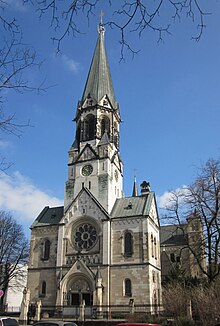John's basilica
The St. John's Basilica on Lilienthalstrasse in the Berlin district of Neukölln in the district of the same name is a Roman Catholic church built between 1894 and 1897, and also the largest Catholic church building in Berlin. In addition to being a parish church , it also serves as the cathedral of the German military ordinariate . The listed church is dedicated to St. John the Baptist consecrated.
history
After the laying of the foundation stone in 1894, St. Johannes was built as a Catholic garrison church not far from Tempelhofer Feld . The architect was the building officer August Menken . He designed the church as a basilica in the Rhenish-Romanesque style. Parallel to St. Johannes, the Protestant church on the southern star was built as a garrison church on today's southern star . The solemn inauguration of the two churches took place on May 8, 1897 in the presence of Emperor Wilhelm II and Empress Auguste Viktoria .
On December 3, 1906, the Johanneskirche was awarded the title of a minor basilica by Pope Pius X as the third German church . The basilica survived both world wars relatively well. During the First World War it was even allowed to keep its bells because of its importance for the military . In the Second World War, however, all but two of these were given up and melted down for war purposes. One of the side towers was damaged in the last days of the war. The main tower and one of the aisles as well as all glass windows were affected. However, the church was used again immediately after the fighting ended. So it could be used for central church services of the diocese of Berlin , since the St. Hedwig's Cathedral was still badly damaged.
With the move of the German federal government, the apostolic nunciature also moved to Berlin and was settled on a plot of land next to the St. John's Basilica. The building was completed in 2001.

In its tradition as a garrison church, the St. John's Basilica has also been the episcopal church of the Catholic military bishop for the Bundeswehr at the seat of the federal government since February 1, 2005 .
After parish mergers in 2004, the parish of St. Johannes became part of the Kreuzberg parish of St. Bonifatius , which also received the parish hall. As part of the Berlin church closings , the Catholic Church of St.-Johannes-Capistran in Berlin-Tempelhof was closed and demolished in 2004 and the St. John's Basilica was then the new church of the Polish-native-speaking congregation.
Architecture and equipment
St. John is a three-aisled basilica on a cross plan with a single-tower west building and a round apse in the east. The main tower initially rises in a square shape above the west bar and ends in an octagonal upper floor with a high cone. Not only the portal facade, but also the facade of the transept arms are richly structured with window rosettes , arched friezes and pilaster strips . The transept facades are also highlighted with narrow side towers. The windows of the nave bays show Romanesque tracery . There is a slim roof turret above the crossing .
The rich neo-Romanesque painting and furnishings have been completely preserved. Particularly eye-catching are the Christ Pantocrator of the apse vault and the altar ciborium . Also noteworthy are the painting of the triumphal arch and the vaulted belts, the rich paintings and carvings of the altars, the organ front and the ornamental floor tiles. The leaded glass windows were completely recreated over decades by Helga Lingnau-Sacks . Among other things, they depict saints from German history and victims of National Socialism . The windows are particularly impressive because of their luminosity.
organ
The organ was built in 1896 by the organ building company Sauer ( Frankfurt / Oder ). The instrument has 38 stops on two manuals and a pedal . The actions are pneumatic .
Around 1950 the organ was rearranged and re-voiced according to plans by Hugo Bergmann, organist of the Heilig-Kreuz-Kirche, whereby the essential sound character was retained.
In 2011 the organ was completely refurbished, whereby the lower octave of the harmony flute 8 ′ was reconstructed and the cylinder function was adapted.
Current disposition
|
|
|
|||||||||||||||||||||||||||||||||||||||||||||||||||||||||||||||||||||||||||||||||||||||||||||||||||||||||||||||||||||||||||||||||||||||||||||||||||
* High pressure
- Coupling : II / I, I / P, II / P, Sup P (not expanded)
- Crescendo roller off
- Hand register
- Fixed combinations: Mezzoforte, Forte, Tutti
Disposition from 1896
The registers from the rearrangement from around 1950 are in brackets. Seven registers have been completely, almost completely removed or shortened.
|
|
|
||||||||||||||||||||||||||||||||||||||||||||||||||||||||||||||||||||||||||||||||||||||||||||||||||||||||||||||||||||||||||||||||||||||||||||||||||||||
Web links
- St. John's Basilica
- Entry in the Berlin State Monument List
- Saint John's Basilica - Church of the Catholic Military Bishop
Individual evidence
Coordinates: 52 ° 29 ′ 15.2 ″ N , 13 ° 24 ′ 31 ″ E


